by: jamie February 14th, 2011 comments:
One of the first questions an astute observer inevitably asks of the Map Kibera team is “how do the residents of Kibera access the map if it’s online?†The answer is that most people don’t have access to the internet, and thus don’t have access to the map of Kibera. This is why we’re aiming to improve our community outreach and engage people with the map offline in Kibera.
In Mathare, we’re working hard to ensure community engagement in the mapping process from the outset. We will also make sure the maps and map data are accessible on and offline and that Mathare residents drive the process.
Last Wednesday we held our second community forum. The purpose of this particular community forum was to present the products of the mapping and media training back to the participants and to other important stakeholders. Â The base map of Mathare already has 750 points, Â 41.3 kms of road, 24 village boundaries and 138 buildings (read more about the base map here).
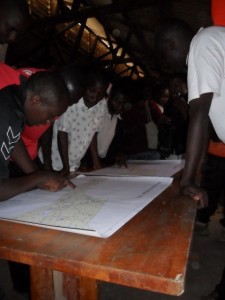
Looking over the Mathare base map
The forum was also an opportunity to discuss the next steps for the mapping work – we are moving on to thematic mapping. Prior to the forum, the training programme planning team (consisting of representatives of Map Kibera, Plan Kenya, Community Cleaning Services, and Mathare residents)  discussed the themes that were most important to us. We settled on water and sanitation, health and education. We agreed that despite the importance of these themes, it was most important to ask the programme participants and other community representatives to identify the themes that resonated with them in their daily lives. What did they want to map?
We printed out maps of the data collected thus far on large sheets and took with us copies of the 4 videos the Mathare videographers had produced.
The forum began shortly after 10am on Wednesday February 9th, with about 160 people in attendance. Simon Kokoyo (the Map Mathare project coordinator) led introductions, asking everyone to stand and state their name and village. It was clear that all villages (and the five wards) in Mathare were represented. There were many familiar faces from the trainings, but also new faces. The Community Cleaning Services (CCS) facilitators and representatives from Dignitas Project and Roots Mathare were there, as well as a public health officer, community health workers, the local area chief and elders. Community Transformers – our host for the training programmes – attended the forum, along with the majority of the training participants.
Simon asked for feedback from mappers  – “What did you learn?†There was mention of learning about technical aspects of mapping: the use of global positioning system (GPS, often used interchangeably with GPRS, despite our attempts to correct this), collecting points, and uploading information. More significantly, participants of the mapping programme discussed how mapping  has helped them identify resources within their villages. One participant mentioned that he realized that he didn’t know his village as well as he thought and there are a lot of resources that are not exploited in Mathare.
The video team talked about what they had learned, including taking shots and editing video. One participant mentioned the use of video to highlight problems and social issues – such as the on-going water shortages in the area.
After the feedback session, Simon divided the room in half – half of the room went back to look at the 2 maps taped on the wall and half watched the videos. We had other maps on the table that some attendees pored over and discussed.

Exploring the map
We had planned to watch the videos together at the beginning of the forum but due to logistical constraints (the extension cable was too short, there were only two power outlets in the whole room and the PA system was using all the outlets) we had to resort to showing the videos in small groups around two laptops.
After everybody had had time to look at the maps and watch the videos, Rose from CCS led look us all through a review – “What did we map?†This feedback session took about 30 minutes – we had answers like clinics, choo (toilet), schools, mpesa points, slaughter house, bridge, matatu stage, etc.
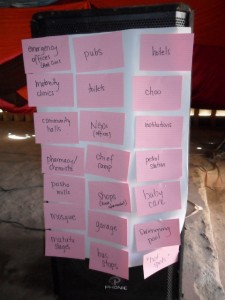
Examples of features collected during mapping
Rose then asked everyone to group these features based on their relationship to one another. Eight “themes†emerged – transport, recreation, businesses, health, water and sanitation, security and institutions, which was further broken into education and institutions. The theme “institutions†also contained churches and there was some debate as to whether churches should fall under education because many schools are run out of church buildings.
After the eight themes were determined, the attendees broke into teams based the five wards in Mathare (Mathare, Mabatini, Mathare North, Huruma, Kiamaiko). Each ward picked the top two themes they wanted to map – based on the importance of the theme in their village. Four of the five wards all picked water and sanitation and health as the top two. The 5th ward (Mathare) picked education and health. So, the themes Mathare residents will map in detail in the coming months are water and sanitation – which really could and should be 2 themes because as we learned in Kibera and from working with CCS, this is a very complicated theme – and health.
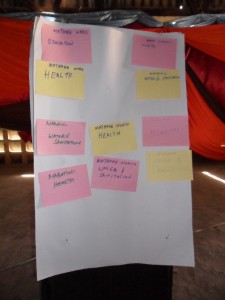
Themes chosen by each ward
It is encouraging and exciting that the two themes (health and water and sanitation) were also themes that the planning committee identified as important. We’re on the right track!
We’ve learned that consensus building is of the utmost importance. Like the first community forum, this second meeting again brought together people of all ages, representing different interest groups. The forum facilitated dialogue among residents of all Mathare’s villages.
This map is for Mathare and the residents of the area need to drive it’s design and development. If they own the process, we hope that they will use the map in future planning and advocacy work. It’s with great pleasure that we can say the excitement and enthusiasm for the Map Mathare training programme is still alive and is in fact still growing.

Mike (an up and coming camera man) practices his new skills by taking footage of Primoz making an announcementÂ
by: jamie January 24th, 2011 comments:
“Participatory methodology (PM): A combination of approach and methods through which people do things themselves interactively. What they do may be appraisal, analysis, planning, action, learning, changing, monitoring, evaluation or other activities”
Robert Chambers. Paradigms, Poverty and Adaptive Pluralism. IDS Working Paper 344. July 2010
Map Kibera did not begin as a participatory development project. The initial project was an attempt to introduce open source technology – namely, OpenStreetMap – into a community that had previously not had a publicly accessible map (for all intents and purposes it was “unmappedâ€). Initial mapping of Kibera was done quickly (in 3 weeks) and local leaders, including administration were consulted but not necessarily engaged in the process. Interest from the international community and the innovative nature of the project fueled its expansion and the local community was left behind.  The entire Map Kibera team has been reflecting on these experiences, individually and as a group, over the last couple of months (read Mikel’s reflection here).
In November 2010, Map Kibera became a research subject. Our initial thoughts were that the research would take away from our work because we would need to give a significant amount of time to focus groups and workshops during a busy time of the year. We were however pleasantly surprised – being subjects of the participatory research process was an invaluable learning experience. We were all able to take time to reflect on the work we had done and consider where the strengths and weaknesses lie. The evaluation of the project – recently shared with us by Samuel Musyoki of Plan Kenya (formerly of Institute of Development Studies (IDS) at University of Sussex) and Mark Skipper of Aptivate – is an important read for anybody interested in ICT4D. Our experience in community engagement has evolved since the early days of the project, particularly because of the team we’ve been working with at IDS.
Map Mathare: employing a participatory approach
Map Mathare is a 4 month training programme in Mathare led by the Map Kibera team. Building on the experiences in Kibera, we hoped to improve the process of community engagement and enhance our skills in participatory storytelling. With advice and leadership from staff at Plan Kenya, we embarked on a journey of community participation in mapping and media. By employing an explicitly participatory methodology, we hope to improve community awareness and impact and reach our main target audience – the people of Mathare.
Our first step was to cross the city (not as easy as it sounds with the Nairobi traffic!) and meet with local youth groups in Mathare. Why? To see if the concept of Map Mathare was of interest to them. Without any interest from the community, we wouldn’t and couldn’t move forward. We had an inclination that there would be support for the concept because we had received a number of invitations to visit Mathare and perhaps start some work there. COOPI, Rebel Film board and Community Cleaning Services all extended invitations separately and we met with their members, who were all excited about the work. We also met with Onserio, the District Officer of Mathare. He was also enthusiastic about the project and began brainstorming ways in which his office could use the information. We continually received calls from Mathare residents who we had met (our first trip there was July) until the day we started on December 1st, 2010. As a colleague recently pointed out, the first important difference between the work in Mathare and Kibera is that Mathare was demand driven, while in Kibera the work was supply driven.
Our second task was to meet and plan the Mathare approach. This was only possible by working closely experienced staff and local leaders, such as Simon Kokoyo – a community development worker with 20 years of experience in Mathare – and Plan Kenya with Community Cleaning Service staff (CCS) – CCS is Plan Kenya’s local partner with experience in facilitating participatory community sanitation work. Of course during this step we secured funding for the project, through a contract with Plan Kenya that is supported DFID (Plan UK) and AusAid (Plan Australia). We also met with the local administration in the area, to ensure support for the mapping process.
Our third step was to formally introduce participatory teaching methods to our Kibera teams. For three days in November, we invaded the NaiLab and were guided through some practical examples and theoretical principles behind inquiry lead learning (ILL). The ILL workshop was facilitated by Mark Skipper from Aptivate. Mark’s challenge, which turns out to be our current challenge in Mathare, was to design a participatory learning experience for 30 young people over 3 days. Of course, his first response was “it can’t be doneâ€. To provide a transformative learning experience, he needed a smaller group. This was not possible we decided – as we had invested countless hours in team-building between the three Map Kibera programmes and were not willing to compromise on who could and couldn’t participate. Mark lived up to the challenge and we thoroughly enjoyed the ILL workshop.  As both a part-time active participant and part-time observer over the three days, I learned that previous workshops we have facilitated have indeed provided hands on participatory and inquiry-led learning experiences. This is mainly because you can’t learn how to use a computer or a GPS or the Ushahidi platform or a flip camera without getting your hands on one and doing it yourself! The workshops and the process were not however participatory in terms of attendance. We’ve had mostly youth attend our sessions and involved in mapping and media work.
Our challenge is thus two-fold
1)     To build participation into the process, encouraging involvement from stakeholders at all levels – women, men, elders, youth, local administration, local elders, you name it!
2)     To facilitate inquiry led learning during the training process – to encourage learning-by-doing and let participants in the training ask and answer their own questions
After the IIL workshop, and many more planning meetings, our fourth step was to get out into the community and discuss the idea with everyone! This was done through a community forum, which was held at St. Teresa’s church on December 1st. The turnout was great! 118 people signed the obligatory “sign-in sheetâ€, while many did not. We estimate the true number to be about 130. Our budget for tea and lunch was shot because there were so many people! The Kibera team presented their work and the Mathare residents discussed the importance of new technology. The group engaged in a “map with your feet” exercise to explore the importance of mapping community resources.
The community forum brought together elders and youth, who identified challenges they are facing including unemployment, tension between local administration and youth, crime, corruption, etc. The general mood of the forum was positive and the attendees were excited to learn from the youth of Kibera.
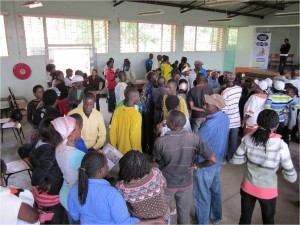
Map with your feet exercise at Mathare community forum
The week after the community forum we began training. Day 1 – we had 45 attendees.  Maureen (a mapper), Joe (from KNN) and Fred (from Voice of Kibera) presented their programmes and discussed the importance of the work they are doing. Primoz presented the theory and concepts behind geographic data. Day 1 complete.
Day 2 – we started with hands on training in mapping and video with 64 participants – some the same, but some different from Day 1
Day 3 – 59 participants
Day 4 – 59 participants
Day 5 – 14 participants (we only did video training this day so we had a smaller group)
As we move forward, the planning team decided we need to improve the learning experience by making (somewhat smaller) groups. We didn’t (and still don’t) want to turn anyone away, because from the perspective of community participation – the more the merrier! We want to generate and sustain support for this programme from within Mathare. The map needs to be the generated by and for the people of Mathare.
But how do you effectively train 80+ people? We had initially planned and thus budgeted to train 40 people!
The tradeoff to ensure true participation is that perhaps not everyone walks away with as much hands-on experience as we would have liked. We hope however by accepting as many people into the training programme as are interested, the Mathare residents will answer the question “whose map?†with the response “ours!â€
Note: of the 84 participants that came through the training programme in December 2010, the average age was 26.2, with a range of 17 -43 years.
This post is part of a series exploring the ideas and issues that have emerged in our research project with Institute of Development Studies, supported by DFID. All posts from the Map Kibera team, the researchers from IDS, our trainers and colleagues are collected here. As always, we are eager to discuss this work, so we hope to hear your comments.
by: jamie October 4th, 2010 comments:
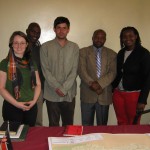
First steps in mapping Mathare: meeting partners & identifying allies. To that end, Primoz and I went along with Rose Nyawira, from Community Cleaning Services who will be involved in the Mathare mapping project, to meet with the District Officer (D.O.) of Mathare. We wanted to tell him about the Map Kibera programmes and the plan to facilitate knowledge sharing and transfer skills from youth in Kibera to youth in Mathare. Onserio, the D.O., was enthusiastic about the plans for putting Mathare on the map and how the data could be used by his office. He asked about the challenges and lessons learned from Kibera to ensure that we would apply the lessons learned in the Mathare work. Also at the meeting was John Kennedy Ogoi, a public health officer in Mathare who is also interested in h0w mapping and social media can support community health workers in the area. Our second meeting of the morning was with a group of 40 or so community health workers who were receiving training and discussing the community development strategy as it relates to public health. When we entered the room, I noticed the group had brainstormed and written on a flip chart the “Factors Hindering Health & Development” in the community. Their list contained many factors, but two jumped out at me
- Lack of individuals voice in decisions affecting them
- Illiteracy, lack of knowledge & skills
These are factors that training and materials that the Map Kibera team can directly address. The use of maps and information submitted through the community information sharing platform, including video reporting are powerful evidence that can be used to raise their voices and influence decisions affecting them. Data collection, mapping, improved spatial awareness, website & knowledge management, video production, etc are all concrete knowledge and/or skills that have impacted the lives of our team from Kibera and can and will address the factors identified by the community health workers . The positive response we got in the two short meetings, with the district administrators and then community health workers in Mathare, are (we hope) an indication of the enthusiasm of the people we will be working with in the area.






